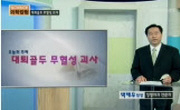목적: 대퇴 골두 무혈성 괴사에 있어 자기공명영상 중 정중 관상면과 정중 시상면에서의 괴사 각도의 합을 측정하여 괴사의 크기를 측정할 경우 향후 대퇴 골두의 붕괴를 예측함에 있어 정...
http://chineseinput.net/에서 pinyin(병음)방식으로 중국어를 변환할 수 있습니다.
변환된 중국어를 복사하여 사용하시면 됩니다.
- 中文 을 입력하시려면 zhongwen을 입력하시고 space를누르시면됩니다.
- 北京 을 입력하시려면 beijing을 입력하시고 space를 누르시면 됩니다.


자기공명영상을 이용한 Kerboul 방법으로의 대퇴 골두 무혈성괴사 범위의 측정 = Measurement of the Extent of Femoral Head Osteonecrosis with a Modified Kerboul Method Using MRI
한글로보기https://www.riss.kr/link?id=A75593187
- 저자
- 발행기관
- 학술지명
- 권호사항
-
발행연도
2004
-
작성언어
-
-
주제어
무혈성 괴사 ; 고관절 ; 대퇴 골두 ; 자기공명영상 ; Hip ; Femoral Head ; Osteonecrosis ; MRI
-
KDC
514.32605
-
등재정보
KCI등재,SCOPUS
-
자료형태
학술저널
- 발행기관 URL
-
수록면
410-416(7쪽)
- 제공처
-
0
상세조회 -
0
다운로드
부가정보
국문 초록 (Abstract)
목적: 대퇴 골두 무혈성 괴사에 있어 자기공명영상 중 정중 관상면과 정중 시상면에서의 괴사 각도의 합을 측정하여 괴사의 크기를 측정할 경우 향후 대퇴 골두의 붕괴를 예측함에 있어 정확한 지 알아보고자 하였다. 대상 및 방법: 단순 방사선 소견 상 대퇴 골두 무혈성 괴사의 소견을 보이는 환자들 중, Ficat 분류 I, IIA 및 IIB기에 해당하는 33명의 환자, 37고관절을 대상으로 고관절 자기공명영상을 촬영하였다. 괴사 크기의 평가를 위해 Kerboul 등의 방법을 사용하였는데 전후 방사선사진과 측면 방사선 사진 대신 자기공명영상 중 정중 관상면과 정중 시상면에서의 괴사 각도를 측정하고 두 값을 더하여 그 값이 200° 미만인 경우를 제 1군으로 분류하고 200°~249°, 250°~299°, 300° 이상인 경우를 각각 제 2, 3, 4군으로 분류하였다. 초기 방사선학적 및 임상적 평가 후 이들 37고관절을 무작위로 두 군으로 분류하여 각각 중심감압술과 보존적 치료를 시행하였으며 최소 5년 이상 또는 대퇴 골두 붕괴가 나타날 때까지 정기적으로 추시하였다. 결과: 제 4 군의 7고관절 모두와, 제 3군의 16고관절 모두가 36개월 이내에 대퇴 골두 붕괴 소견을 보였고, 제 2군의 9고관절 중 6예에서 대퇴 골두 붕괴 소견이 나타났으며, 제 1군의 5고관절에서는 대퇴 골두 붕괴가 없었다. 후향적으로 분석한 바 괴사 각도의 합이 190°미만인 경우에는(저 위험군) 대퇴 골두 붕괴가 없었고, 괴사 각도의 합이 240°보다 큰(고 위험군) 모든 예에서 붕괴 소견이 나타났으며, 190°와 240°사이의(중등도 위험군) 8고관절 중 4예에서 붕괴가 발생하였다. 결론: 대퇴 골두 무혈성 괴사환자의 자기공명영상을 이용한 괴사각 합산법이 향후 대퇴 골두의 붕괴 가능성을 예측하는 유용한 지표로 이용될 수 있을 것으로 사료된다.
다국어 초록 (Multilingual Abstract)
Purpose: We tested the hypothesis that combined necrotic angle measurement using MRI scans can predict the subsequent risk for collapse of femoral head osteonecrosis. Materials and Methods: Thirty-seven hips with early-stage (Ficat stage I, IIA or IIB...
Purpose: We tested the hypothesis that combined necrotic angle measurement using MRI scans can predict the subsequent risk for collapse of femoral head osteonecrosis. Materials and Methods: Thirty-seven hips with early-stage (Ficat stage I, IIA or IIB) osteonecrosis in 33 consecutive patients were investigated. The arc of the necrosis was measured by the method of Kerboul et al. using the mid-coronal and mid-sagittal MRI scans of the femoral head instead of the anteroposterior and lateral radiographies, and the two angles were added. The patients` hips were classified into four categories based on the magnitude of the added angle; grade 1(<200°), grade 2(200°~249°), grade 3(250°~299°), and grade 4(>300°). After the initial evaluations, the hips were randomly assigned to the core-decompression group or the conservatively-treated group. Patients underwent regular follow-up until the femoral head collapsed or for a minimum of five years. Results: Seven grade 4 hips and 16 grade 3 hips developed femoral head collapse within 36 months; six out of nine grade 2 hips, and none of five grade 1 hips developed collapse (log rank test, p<0.01). On the retrospective analysis, none of the four hips with a combined necrotic angle <190°(the low risk group) collapsed, all 25 hips with a combined necrotic angle >240°(the high risk group) collapsed, and four (50%) of eight hips with a combined necrotic angle between 190°and 240°(the moderate risk group) collapsed during the study. Conclusion: The Kerboul combined necrotic angle ascertained by MRI scans instead of using radiographies might be a major predictor of future collapse for osteonecrosis of the femoral head.
동일학술지(권/호) 다른 논문
-
- 대한고관절학회
- 황득수 ( Deuk Soo Hwang )
- 2004
- KCI등재,SCOPUS
-
2공 측면 금속판 압박 고 나사를 이용한 안정성 대퇴골 전자간 골절의 치료
- 대한고관절학회
- 이승용 ( Seung Yong Lee )
- 2004
- KCI등재,SCOPUS
-
고령의 골다공증 환자의 대퇴골 전자부 골절에 활강 압박 고나사 고정시 시멘트보강군과 비시멘트군의 결과 비교
- 대한고관절학회
- 박명식 ( Myung Sik Park )
- 2004
- KCI등재,SCOPUS
-
인공고관절 전치환술 후에 발생한 삽입물 주위 골절의 치료
- 대한고관절학회
- 이준영 ( Jun Young Lee )
- 2004
- KCI등재,SCOPUS




 KCI
KCI KISS
KISS






